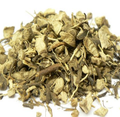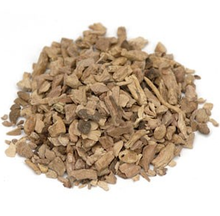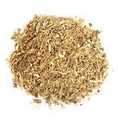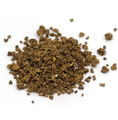 Loading... Please wait...
Loading... Please wait...- Home
- Bulk Herbs
- Herbs (Q-R)
- Red Root
Red Root
Product Description
Red Root
Wild Crafted - USA
Also Known As – Ceanothus americanus, Jersey tea, New Jersey tea
Overview - Ceanothus americanus is indigenous to the United States, and is very abundant in the West; it grows in dry woodlands, barrens, etc., flowering from June to August. The leaves are astringent and slightly bitter, and have been used as a substitute for tea, to which they have a strong resemblance when dried, both in taste and odor. The root is the medicinal part, and has a taste and smell somewhat resembling those of the peach leaf. It has been occasionally used for coloring. Water extracts its active principle.
Medicinal Uses – Astringent, expectorant, sedative, antispasmodic, and antisyphilitic. It is used in gonorrhoea, dysentery, asthma, chronic bronchitis, whooping-cough, and other pulmonary affections.
Besides the old uses, as given above, ceanothus has been found to be a useful gastric, hepatic, and splenic stimulant, and it is in splenic troubles that its action is most favorable. Scudder (Spec. Med.), states that it is indicated by splenic enlargement, with sallow, doughy skin, and expressionless face. Webster gives as indications, deep-seated splenic pain, though no enlargement be detectable, and for the pain of splenic hypertrophy, as well as for sympathetic, painful conditions depending upon splenic wrong. Its action is compared to that of carduus marianus, influencing the hepatic, and more so the splenic vessels, overcoming congestion. Hypertrophy of the spleen and splenitis of malarial origin are met with it. The cases of splenitis to which it is specially adapted are not acute, but rather sub-acute, after the active symptoms have passed, and when pressure does not markedly aggravate the pain. It was much used during the Civil War for malarial splenitis. Copious catarrhal profluvia in non-inflammatory conditions are benefited by its astringency.
Native American Uses of Red Root
We learned many uses of red root from the Native Americans. The Cherokee used the root as a digestive aid. The Chippewa used the root for constipation and bloating, pulmonary troubles and shortness of breath. The Iroquois made a decoction of the leaves, which are said to be more astringent than the root, for diarrhea, and the root for the blood and colds. Many tribes also found that it was helpful as a wash for wound healing, probably due to its astringent properties, and for healing the sores of venereal disease.
Modern Day Uses of Red Root
Today, we look at how red root functions in the body. Red root stimulates lymph and interstitial fluid circulation. It acts as an anti-inflammatory to the spleen and lymph nodes, prevents blood that is high in fat from clumping, and smoothes stomach and intestinal function. The blood transports better, because inflammation across the surface of the lymph nodes is decreased, and bioavailability of nutrients to the cells is increased. We see cases of malabsorption improve dramatically with the introduction of red root. It is a plant that clears excess secretion, and tightens tissue, influencing function to improve. When this occurs, blood is built, improving anemic conditions, cells and muscles receive their proper nutrients, and appetite and immunity improve.
There are many ways to apply red root to dysfunction in the body. In my practice, I recognize that the spleen plays a major role in digestive function, and when digestive disorders are present on a disease or syndrome level, deficiency of the spleen is a contributing factor. Spleen deficiency appears in Irritable Bowel Syndrome and Irritable Bowel Disease (Chron’s and Colitis), where there is impaired uptake of nutrients and an imbalance between wet and dry in the gut, and they respond very well to red root as a long-term tonic at moderately low doses.
The astringent qualities that dry up damp conditions aid conditions where lymphatic congestion is a problem. Mastitis, mononucleosis, tonsillitis and strep infections all find relief from red root. It reduces lymphatic swelling, and sooths sore throats. I often combine red root with other lymphatics, as well as herbs specific to the illness.
Chronic conditions that affect lymphatic function respond well to red root. They are leukemia, Hodgkin’s disease, rheumatism, AIDS and various types of anemias. Please consult someone clinically trained in herbal medicine and experienced in working with these conditions before embarking on your herb journey if you have a positive diagnosis for these diseases.
Because red root has a grand effect on overactive mucosa, it is an excellent expectorant. This is one area where the leaves are a successful treatment. I have found use for them in respiratory illnesses, such as bronchitis, both acute and chronic, and sore throats. I don’t employ the leaves alone, but often combine them with the root of the plant.
Herbs that support lymphatic function do so in many different ways. While I hear many speak of lymphatic herbs as being blood cleansers, we must remember that organs – not plants – clean blood. Plants stimulate and support the process, retraining the body in a function that was forgotten. In the case of disease, where blood is weak, herbs support recuperative function, and when the spleen and lymphatic system have been disabled, it is important to support those functions to increase healing potential.
Parts Used - Root and bark.
Suggested - I find small to moderate doses of this herb to be most effective and appropriate, larger doses can emphasize the astringent qualities and create digestive problems. Tincture dosage for an average sized adult is usually 15-30 drops for chronic conditions.
Disclaimer - The information presented herein by Mountain Maus’ Remedies is intended for educational purposes only. These statements have not been evaluated by the FDA and are not intended to diagnose, cure, treat or prevent disease. Individual results may vary, and before using any supplements, it is always advisable to consult with your own health care provider.
Find Similar Products by Tag
Find Similar Products by Category

Product Reviews
-
Quick shipment

Posted by Angyana on 24th Oct 2019
Quick shipment to UK using this tea for the first time I have tried to brew twice the tea and still have the taste and colour I can see an improvement on my skin .
Happy I have purchased a 1lb of this tea.
-
Fresh!

Posted by Stephen Tippens on 14th Mar 2018
The freshest I have ever purchased and I purchase quite a bit from other vendors. I will be back for more.














